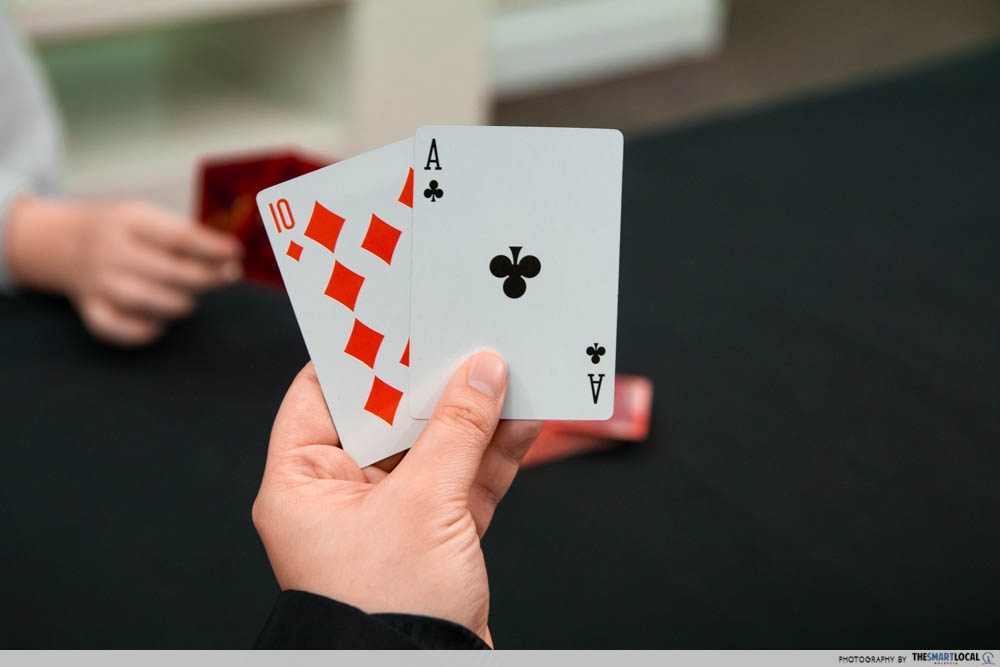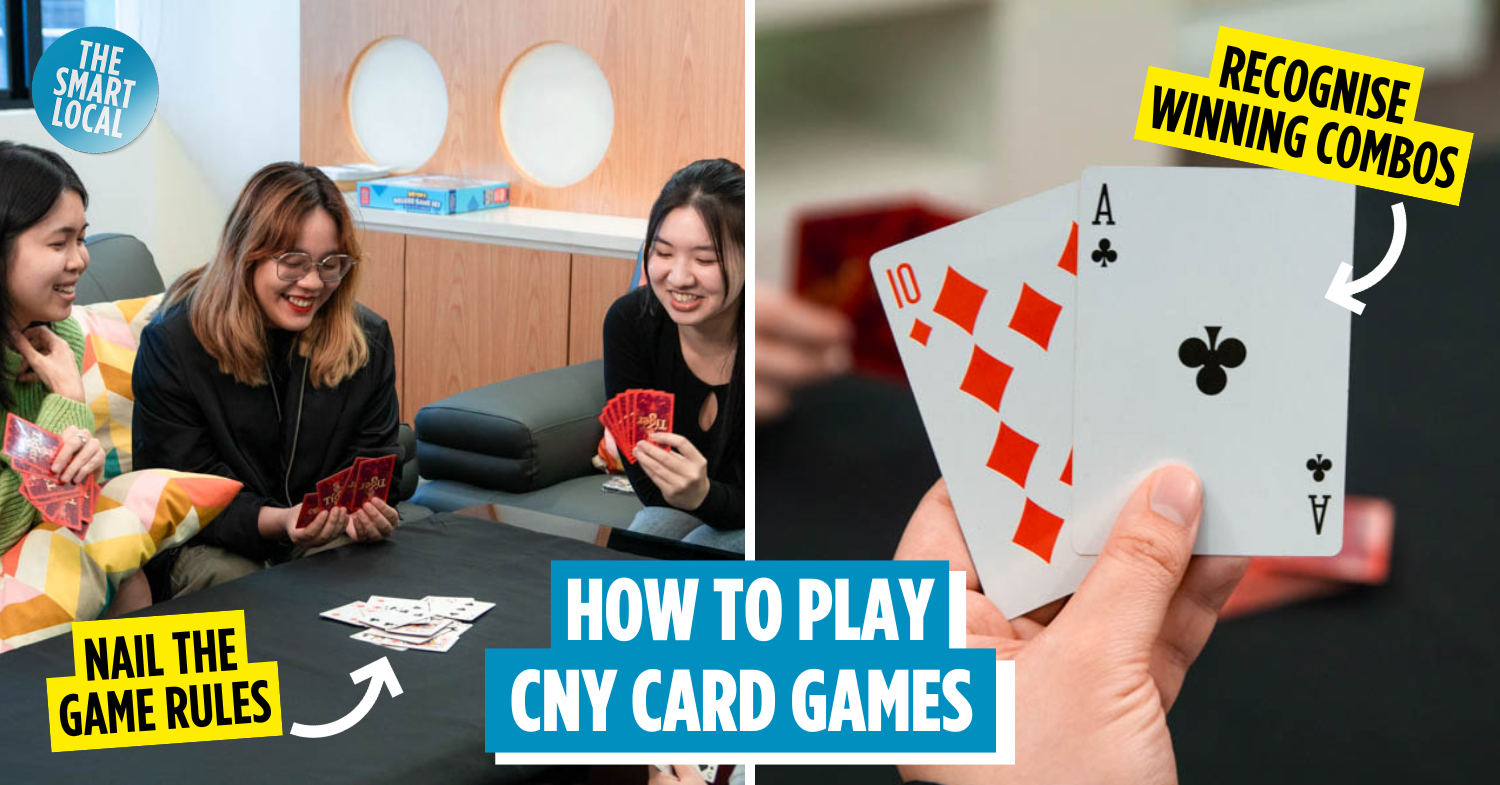Playing card games for Chinese New Year
Chinese New Year has always been an incredibly jovial festivity for many reasons. Food and snacks are plentiful, chatters of loved ones fill the air, ang paus are in abundance, and hence, card games are incessant. Friendly and responsible games, that is. Such is the tradition of the CNY celebrations, as Chinese culture has always been fond of a little cheek and fun in the form of playing card games.
If this CNY will be your first time joining in on the playing card fun, we’ve put together this handy guide to understanding the rules of classic games so you can have some fun with your ang pau earnings.
1. Ban Luck

Chinese Blackjack, also more commonly known as Ban Luck in Malaysia, is arguably the most popular card game to play during CNY reunions. As a Chinese variation of the classic blackjack game, it is absurdly simple yet a ton of fun – first-timers need not be intimidated by the easy-to-grasp rules.
Your goal will be to draw cards that add up to as close to 21 points as possible, without going over the amount.

The dealer first shuffles the deck of cards and each player – including the dealer – will receive two cards, facing down. Players can proceed to open their set of cards to add up their scores according to their values.
Point counting rules:
- Cards with numerics of 2 to 9 are worth their face value
- Cards 10, J, Q, and K represent 10 points
- Ace cards are worth either a point or 11 points
Depending on the total score, players can choose to draw another card or keep their current set on hand. Those with over 21 points are eliminated from the round, and the player who gets exactly or the closest amount to 21 points, wins the round.
If the dealer’s card combo exceeds 21 points, all remaining players win the round.
2. Shi San Zhang

Chinese Poker, or Shi San Zhang which translates to “13 cards” in English, is similar to the classic poker. But those who are not familiar with the card game may find it a wee bit more complicated.
Usually played in groups of 2-4 players, each player is dealt 13 cards, which are then divided into 3 hands in total – 2 hands of 5 cards, and another hand of 3 cards. To win the game, players are required to come up with the best possible combination of cards with the ones they have.

Possible hand combinations:
- Royal Flush: 10, J, Q, K and Ace all in the same suit
- Straight flush: Five cards of the same suit, in sequential order
- Four of a kind: Any four cards of the same number
- Full house: A combination of three cards of the same number and a pair of the same
- Flush: Five cards of the same suit, in any order
- Straight: Five cards of numbers in sequential order
- Three of a kind: Any three cards of the same number
- Two pair: Two different pairs of matching numbers, in the same hand
- One pair: Any two cards with matching numbers
- High card: The highest ranked card in your hand, with Ace being the highest and 2 ranked the lowest
3. Chor Tai Ti

Another CNY favourite, Chor Tai Ti is a variation of Chinese Poker, best played in a quintessentially Chinese way – with snacks and some ang pau in the mix. The objective is simple: to be rid of all the cards in your hands, by one-upping your opponents along the way.
In groups of four, distribute a deck of cards equally among the players, and the remaining cards can be placed in a “pass” pile for later. The player with the card of the smallest value will start the game by placing the card out, facing upwards. The rest of the players will then take turns to put out a card of a higher value to beat out the previous player.
Card values:
- Cards with number 3s are ranked the lowest, followed by the 4s and so on till the Aces. The 2s are the strongest numbers.
- The suits are ranked from weakest to strongest in the following order: diamonds, clubs, hearts, and spades.

Following these values, the card of the smallest value that the first player must start the game with is 3 of diamonds, and the strongest will be 2 of spades – hence, the name of the game, Chor Tai Ti meaning “big two” in English.
The first player also determines the number of cards each player must play that round. For instance, if the player plays with a single card, then the round must be played with one card. If a combination of cards is played, then all other players must play with the same number of cards in that combination.
The winner will be the player who finishes all the cards in hand.
Rank of cards, from high to low: A K Q J 10 9 8 7 6 5 4 3 2
4. Baccarat

Put math and luck together, and you’ll get Baccarat. Players are dealt with two cards from the dealer, and the goal of the game is to bet on the hand that you believe contains numbers that will add up to a total of an amount closest to 9.
When the cards are revealed to each player, they must decide if they choose to keep their current hand of cards or draw one more card. The deciding factor for this would be the added value of both cards. The player who receives a total hand close to the amount of 9 achieves a natural win, so no further card needs to be drawn.

Calculations for cards:
- Cards with numerics 2 to 9 have values that are equal to their face value
- Cards 10, J, Q, and K have a value of zero, while the Ace cards equal to 1
- The total of a hand is determined by adding up the values of the cards. If total values are double digits, the final value would be the rightmost digit of the sum. For instance, if you have a 7 and 8 on hand, your hand’s total would be 5 (from 15)
5. Gnau

Gnau, which means “ox” in English, is a rather special game for us Malaysians – it originated in our home country. Fair warning though, as it can be quite a complex game to learn. If you want to take a shot at this game, we’re here to break down the rules of the simpler version for you.
A larger group of people would be great for this game, which is preferably played among up to 10 players or even more. To start, each player receives 5 cards from the dealer and the goal for this round is to pick out 3 cards out of the 5 that can be added to make a multiple of 10 (10, 20, 30).
Point counting rules:
- Cards with numerics of 2 to 9 are worth their face value
- Cards 10, J, Q, and K represent 10 points
- Ace cards are worth either a point or 11 points
For starters, if 3 of a player’s cards are 2, 8, and J, these would add up to 20. And here you have your “Ox” or “Passport”. By identifying these 3 cards, a player is then “eligible” for scoring.
Now that you have your “Ox” cards, the remaining 2 cards will be used to determine your “Ox power”. To win, the last 2 cards of a player will have to amount to a total score of 10.
6. In-Between
In-Between is a great poker card game to play when everyone starts to get a little bored of the catch-up and tea-spilling sesh, and when the party needs a little buzz and thrill. It amps up the fun levels in a room rather quickly, as it is extremely fast-paced and easy to learn.

You’ll need the essentials – a deck of shuffled cards and something to bet on. Each player must chip in an equal amount of bets to start the game.
After the dealer has dealt two cards facing upwards to the first player, the player then bets an amount according to the chance of the next card number falling between those two numbers on the opened cards. Suits don’t matter in this game, just the face value of the individual card.
The player is allowed to bet as much as the amount already in the pot. If the number on the third card does fall between the first two cards, then they win the amount of the bet from the pot. If the number falls outside, they lose the amount of bet to the pot. If the odds aren’t in your favour, and the third card has a number that matches any of the first two dealt, the player loses double the amount bet to the pot.
Classic playing card games to crank up the fun during CNY
Along with bubbling hotpot stew, plump pineapple tarts, the deafening clash of cymbals, and the prancing of furry lions during the auspicious CNY, there are playing card games galore.
You know the fun’s never going to end, so why not earn a couple of bucks while you’re at it? It also helps that indulging in rounds of games during a reunion symbolises the welcome of good luck and prosperity. So familiarise yourself with these CNY card games, pray to the ong Gods, and play away!
For more CNY-related articles, read:
- Chinese New Year greetings and phrases to master
- Unique CNY recipes to whip up
- Common CNY superstitions in Malaysia
Cover image adapted from: TheSmartLocal Malaysia
Photography by Hans Leong.
